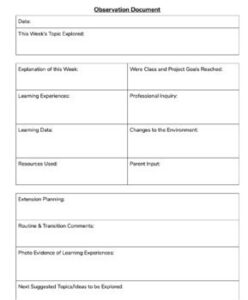In the vibrant and often demanding world of early childhood education, the well-being and insights of your staff are truly invaluable. They are the heart and soul of your program, directly influencing the learning environment and the development of young children. However, knowing how your team truly feels, understanding their challenges, and recognizing their successes can be a complex endeavor without a structured approach.
This is where a well-crafted early childhood staff survey template becomes an indispensable tool. It provides a systematic way to gather honest, actionable feedback, helping you identify areas for improvement, celebrate what’s working well, and foster a more supportive and engaging workplace. By using a template, you streamline the process, ensure consistency, and ultimately build a stronger foundation for both your team and the children they serve.
Why a Dedicated Early Childhood Staff Survey Template Matters
Think about the daily grind of early childhood educators: the boundless energy required, the emotional investment, the constant problem-solving, and the deep commitment to nurturing young minds. It’s a rewarding profession, but also one that can lead to burnout if not properly supported. Listening to your staff isn’t just a nice-to-have; it’s a critical component of maintaining a healthy, high-performing team and ensuring the quality of your educational programming. A specific survey designed for this sector acknowledges their unique contributions and challenges.
A well-structured survey acts as a direct line of communication, allowing staff to share their perspectives on everything from daily operations and resources to leadership support and professional growth. This feedback can illuminate blind spots you might not even be aware of, revealing underlying issues that could be affecting morale, productivity, or even staff retention. Conversely, it can also highlight areas where your center truly excels, providing valuable insights into what makes your team feel valued and motivated.
Beyond problem-solving, conducting regular staff surveys demonstrates a profound respect for your employees. It shows them that their opinions matter, that their experiences are valid, and that you are genuinely invested in their well-being and professional development. This acknowledgment alone can significantly boost morale, foster a stronger sense of belonging, and build a culture of trust and transparency within your early childhood setting.
Key Areas to Explore in Your Survey
When developing or selecting an early childhood staff survey template, it’s crucial to cover a comprehensive range of topics that are relevant to the unique context of early childhood education. This ensures you gather a holistic view of the staff experience. Consider including questions that touch upon the following essential aspects:
- Workload and Staffing Levels: Are educators feeling overwhelmed? Do they have enough support to manage their classrooms effectively?
- Professional Development Opportunities: Do staff feel they have access to relevant training and growth opportunities? Are their skills being utilized and expanded?
- Communication and Team Collaboration: How effective is communication within the team and with leadership? Do staff feel supported by their colleagues?
- Resources and Environment: Are the physical resources (materials, space, equipment) adequate and conducive to learning and teaching?
- Leadership Support and Recognition: Do staff feel appreciated and understood by their supervisors? Is feedback constructive and regular?
- Work-Life Balance and Well-being: Are there systems in place to support staff well-being? Do they feel they can maintain a healthy balance between work and personal life?
By delving into these specific areas, your survey can provide a nuanced understanding of staff sentiment, helping you pinpoint precise areas for strategic intervention and improvement within your early childhood program.
Crafting and Implementing Your Survey Effectively
Once you have a solid early childhood staff survey template, the next step is to ensure its effective implementation to maximize its value. The way you introduce, distribute, and follow up on the survey can significantly impact the quality of the feedback you receive and your staff’s willingness to participate honestly. It’s not just about asking questions; it’s about creating an environment where truth is welcome and acted upon.
Firstly, emphasize anonymity and confidentiality. Staff members are far more likely to provide candid feedback if they are confident that their responses will not be linked back to them personally. Clearly communicate how the data will be collected, analyzed, and used – for collective improvement, not individual performance reviews. Providing options for anonymous submission, whether through an online platform or a physical suggestion box, is crucial for fostering trust.
When formulating questions, aim for clarity, conciseness, and neutrality. Avoid leading questions or those that can be answered with a simple yes or no if you’re looking for deeper insights. Open-ended questions are excellent for gathering qualitative data and allowing staff to elaborate on their experiences, providing context and rich detail that quantitative data alone cannot capture. Balance these with rating scales for easily measurable insights.
The real power of any survey lies not in its completion, but in the actions taken afterward. Once the responses are gathered, dedicate time to thoroughly analyze the data. Look for recurring themes, significant discrepancies, and both positive and negative outliers. Share a summary of the findings with your staff, demonstrating that their input has been carefully considered. Transparency about the results builds trust and reinforces the idea that their voices truly matter.
Finally, and most critically, develop an action plan based on the survey feedback. This means identifying specific areas for improvement and outlining concrete steps you will take to address them. Communicate these plans to your staff and follow through on your commitments. Even small changes, if directly responsive to their feedback, can have a huge positive impact on morale and the overall work environment. Regular check-ins on progress will further solidify your commitment to a supportive and responsive workplace.
Ultimately, investing in a robust feedback mechanism for your early childhood staff is an investment in the entire organization. When educators feel heard, valued, and supported, they are more engaged, resilient, and effective in their roles. This positive shift directly translates into a more nurturing, stimulating, and stable environment for the children in their care, fostering better learning outcomes and healthier early development.
By consistently seeking out and acting upon the insights of your dedicated team, you are not just improving a workplace; you are strengthening the very foundation of quality early childhood education, ensuring a brighter future for both your staff and the young learners they inspire every single day.


